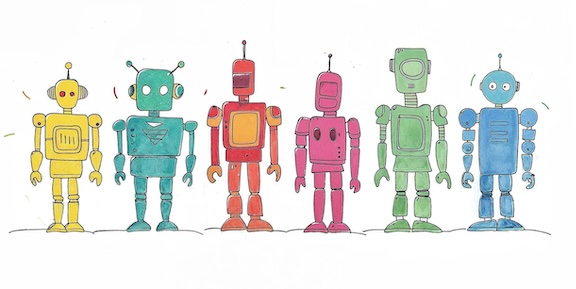Things are changing pretty quickly out there with companies of all sizes thriving when their employees are actively engaged in generating and exploring new ideas. The need for a continuous flow of innovation is essential for staying attuned to both internal operational needs and external market demands. However, the key to successful innovation lies not just in the generation of ideas, but in fostering an environment where these ideas can be properly evaluated, refined, and implemented. While it’s crucial to encourage creativity and experimentation, it’s equally important to have robust review processes in place to ensure that the most viable and valuable ideas make it to production. I think of myself as a bit of a “project whisperer,” I’ve learned through experimentation and tuning valuable lessons about striking this delicate balance and nurturing a culture of responsible innovation within team settings.
The Challenge of Idea Implementation
Early in my career, I often found myself discouraged when my ideas were met with polite rejection: “Thanks, but I don’t think that will work for us. Keep coming up with ideas, though!” This constant pushback led me to question whether the problem lay with me, my presentation of the idea, or with the ideas themselves.
An Approach: Encouraging Others
To test this theory, I began encouraging others to develop ideas, often starting with my own as a kicking off point. I noticed that many team members struggled to generate ideas independently, it isn’t always key to places they may have worked before so it can be a new challenge. By introducing my ideas and inviting others to work on them, I created opportunities for colleagues to engage with problem-solving in a low-pressure environment.
This approach yielded multiple benefits. It provided a starting point for those who found idea generation challenging, allowing them to build upon an existing concept rather than facing the daunting task of creating something from scratch. Team members felt more confident working through problems when given an initial direction, which often led to them contributing their own unique insights and modifications. Perhaps most importantly, it fostered a collaborative atmosphere where people felt comfortable building upon and improving existing ideas.
The results were enlightening: some ideas flourished, while others faltered. Importantly, team members began to feel more comfortable contributing their own thoughts and modifications as time went on. This experience taught me a crucial lesson: success isn’t about having a 100% hit rate on ideas, but about creating an environment where ideas can be explored and refined collectively. By encouraging participation and valuing input from all team members, we created a space where innovation could thrive, regardless of where the initial spark came from.
The Reality of Idea Generation
Innovation is fundamentally a numbers game, requiring a multifaceted approach to idea cultivation. It demands a commitment to continuously generating ideas while simultaneously encouraging others to do the same. This process thrives on openness—being receptive to both your own ideas and those originating from team members. The key lies in persistent effort, working through challenges collaboratively, and understanding that each idea, whether it succeeds or not, contributes to the collective learning experience. By embracing this reality, teams can create a fertile ground for innovation where creativity flourishes and breakthroughs become possible.
The Path Forward
While only a small percentage of ideas may lead to impactful projects, the key is to keep the process alive. Encourage your team to:
- Share ideas freely
- Embrace the possibility of failure
- Support each other’s creative processes
- Celebrate both successes and learning experiences
The role of a “project whisperer” extends beyond helping with the answers. It involves cultivating an environment where ideas can take root, evolve, and occasionally, against considerable odds, blossom into groundbreaking innovations. This approach fosters a culture of creativity where every team member feels empowered to contribute, regardless of the immediate outcome. The next transformative idea may be just moments away, waiting for the right conditions to emerge.
However, fostering this culture of innovation can be challenging, especially when team members are hesitant to engage with ideas or projects that aren’t explicitly required by their job descriptions. When faced with a coworker who isn’t initiating work on a promising idea or project due to its optional nature, consider a few strategies I have used:
- Highlight the potential benefits: Discuss how engaging with the project could lead to personal growth, skill development, or career advancement opportunities. Frame the project as an investment in their professional future.
- Find alignment with current responsibilities: Help your coworker see how the project might complement or enhance their existing work. Look for ways to integrate the new idea into their regular workflow.
- Break it down: If the project seems overwhelming, break it into smaller, more manageable tasks. Suggest starting with a small, low-commitment aspect of the project to build momentum.
- Offer collaboration: Propose working on the project together. Your enthusiasm and support might be the encouragement they need to get started.
- Seek managerial support: If appropriate, discuss the project’s potential value with a manager. They might be able to allocate official time or resources to the project, making it easier for your coworker to justify their involvement.
- Create a safe space for experimentation: Emphasize that the goal is to learn and innovate, not to achieve perfection. Ensure that there’s no penalty for trying new things, even if they don’t always succeed.
- Recognize and reward initiative: Publicly acknowledge team members who take on optional projects. This can create a positive reinforcement cycle that encourages others to do the same.
- Be sure there is an understanding of how far a project can go before needing a company overview. Sometimes this includes the team member understand there won’t be blame or career challenges if the idea doesn’t move forward past a proof-of-concept.
Give these a try to help overcome inertia and foster a more proactive approach to innovation within your team. The goal is to create an environment where everyone feels empowered and motivated to contribute their ideas and efforts, even when it’s not explicitly part of their job description.
By maintaining this approach, you create a culture of innovation where every team member feels empowered to contribute, regardless of the outcome. After all, the next groundbreaking idea could be just around the corner.
Embracing AI as an Ideation Partner
There is no way to not discuss AI integration here too, it’s worth noting that artificial intelligence can be a valuable partner in the ideation process. When team members find themselves facing creative blocks, engaging with AI tools can generate a multitude of ideas rapidly. While not every AI-generated concept will be a perfect fit for the specific needs of the team or project, these ideas can serve as powerful catalysts, jump-starting the creative process and inspiring new directions of thought. By incorporating AI as a brainstorming tool, individuals can expand their creative horizons, overcome mental hurdles, and potentially uncover innovative solutions they might not have considered otherwise. The key is to view AI as a collaborative partner in the ideation journey, using its output as a springboard for human creativity and refinement.
Outside of my AI partner, I personally have processes that help find ideas in everyday things and occurrences. I will cover that later here, this article was already getting long.
Please note that if you purchase from clicking on a link, it may result in my getting a tiny bit of that sale to help keep this site going. If you enjoy my work, perhaps you would consider donating to my daily cup of coffee, thank you.










